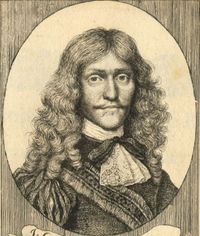|
|
You are not currently logged in. Are you accessing the unsecure (http) portal? Click here to switch to the secure portal. |
Johannes Georgius Bruchius
| Johannes Georgius Bruchius | |
|---|---|
 | |
| Born | ca. 1630 Zweibrücken, Germany |
| Died | 1717-1718 Utrecht, Netherlands |
| Occupation | Fencing master |
| Influences | |
| Influenced | Johann Andreas Schmidt |
| Genres | Fencing manual |
| Language | Early New High German |
| Notable work(s) | Grondige Beschryvinge van de Edele ende Ridderlijcke Scherm- ofte Wapen-Konste (1671) |
Johannes Georgius Bruchius was a 17th century German fencing master. He was born in Zweibrücken, Germany in ca. 1630, and by 1653 he was working as a fencing master in Heidelberg. In 1655, Bruchius transplanted to Utrecht, Netherlands, where on 6 March the city council authorized him to teach public classes; the official record notes that he was requested by a number of German nobles. In 1660, he accepted a position as fencing master at the prestigious Universiteit Leiden, where he taught for at least eleven years. Some time between 1671 and 1676, Bruchius opened a new school in Amsterdam where his students included Johann Andreas Schmidt, a fellow German who would himself go on to be a fencing master and author.[1]
In 1671, Bruchius published an extensive fencing manual entitled Grondige Beschryvinge van de Edele ende Ridderlijcke Scherm- ofte Wapen-Konste ("Thorough Description of the Noble and Knightly Fencing- or Weapon-Art"). It was published in Leiden by Abraham Verhoef, and treated the use of the single rapier after the German manner, which was itself heavily influenced by the teachings of the Italian master Salvator Fabris.[1]
In 1580, Bruchius returned to Utrecht and his activities thereafter are unknown (though it's likely that he continued teaching fencing). He appears to have died in Utrecht between 1717 and 1718.[1]
Contents
Treatise
| Images | No Translation |
Transcription
|
|---|---|---|
| Text to copy over |
Additional Resources
References
- ↑ 1.0 1.1 1.2 Reinier van Noort. "Johannes Georgius Bruchius". School voor Historische Schermkunsten. Retrieved 22 February 2013.
